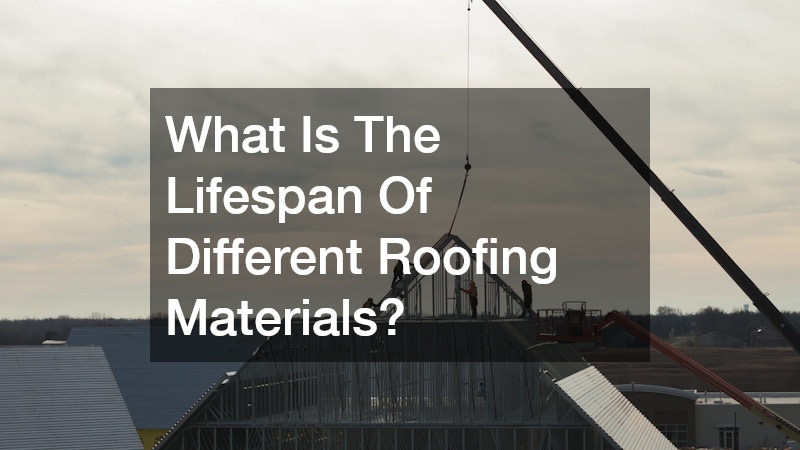Understanding the importance of selecting the right roofing material is crucial for both the aesthetic and functional aspects of a home. A roof not only protects your home from the elements but also significantly impacts your property’s value, energy efficiency, and visual appeal. With so many materials available on the market today, homeowners need a clear understanding of the benefits and drawbacks of each option. This article will guide you through the different types of roofing materials and provide detailed insights to help you make an informed decision. Whether you’re working with a trusted roofing contractor or evaluating options recommended by local roofers, knowing what each material offers is essential to achieving a durable and beautiful result.
What Are The Different Types Of Roofing Materials?

Asphalt Shingles
Asphalt shingles are one of the most commonly used roofing materials in the United States. They are affordable, widely available, and easy to install. Shingles come in a range of colors and styles, making them versatile for various architectural designs. They offer decent durability and a lifespan of 15 to 30 years, depending on the quality. Shingles are also easy to repair or replace, especially if you’re working with experienced local roofers who understand how to match them seamlessly.
Metal Roofing
Metal roofing has surged in popularity thanks to its longevity and durability. Options include aluminum, steel, copper, and zinc. Metal roofs are resistant to harsh weather, including hail and high winds, and they are also fire-resistant. They can last 40 to 70 years with minimal maintenance and are recyclable, making them environmentally friendly. A knowledgeable roofing contractor can explain the differences between standing seam and corrugated metal panels, helping you choose the best fit for your budget and climate.
Wood Shingles And Shakes
Wood shingles and shakes offer a natural, rustic appearance that complements many traditional home styles. Made from cedar, redwood, or pine, they provide good insulation but require regular maintenance to prevent mold, mildew, and insect damage. Their lifespan ranges from 20 to 40 years depending on climate and upkeep. Wood roofing is often favored for historic renovations, though it’s important to consult a roofing contractor who understands the treatment and sealing process required to keep wood roofs in good condition.
Tile And Cement
Clay and concrete tile roofs are durable and resistant to fire, rot, and insects. Tile roofs are often used in Mediterranean, Spanish, or Southwestern-style homes and are well suited to hot, arid climates. These materials can last up to 50 years or more but are heavier than other options, often requiring structural reinforcement. When upgrading to tile roofs, homeowners should factor in the potential need for roll off dumpsters to manage the heavier waste generated during tear-off.
Slate Roofing
Slate is one of the most durable and aesthetically refined roofing materials available. Quarried from natural stone, it has a sophisticated look and can last over 100 years. However, slate is expensive and heavy, making installation more complex and costly than other materials. Local roofers with experience in slate work can help ensure the installation process preserves the integrity of both the roofing system and the home’s structure.
TPO Roofing
Thermoplastic polyolefin (TPO) roofing is a popular option for flat or low-slope roofs, especially in modern home construction. TPO roofing offers high energy efficiency and reflects UV rays, keeping homes cooler in hot climates. It’s also highly resistant to punctures, algae, and chemical exposure. While typically seen in commercial buildings, some homeowners are opting for TPO roofing in certain residential applications for its low maintenance requirements and performance benefits.
How Do I Determine The Best Roofing Material For My Climate?
Factors To Consider In Cold Climates
In areas with heavy snowfall and freezing temperatures, materials that can withstand ice dams and cold weather are essential. Asphalt shingles with proper underlayment and metal roofing systems perform well in these conditions due to their shedding capabilities and resilience to freezing temperatures. Regular roof inspections are also necessary in colder regions to identify and prevent moisture buildup that can damage roofing materials over time.
Roofing Solutions For Hot Climates
Homes in hot, sunny areas benefit from reflective roofing materials such as TPO roofing or metal roofing with reflective coatings. These materials help deflect solar radiation and reduce attic heat gain. Tile roofs also work well in hot climates, thanks to their natural thermal resistance and insulating airspace beneath each tile.
Adapting To Wet And Humid Climates
In wet or humid areas, roofing materials must resist mold, algae, and water absorption. Metal roofing and slate are excellent choices, offering long-term durability and moisture resistance. Regular maintenance and roof inspections are critical in these environments to catch issues early and prevent deterioration.
Roofing For Areas Prone To High Winds
If you live in an area susceptible to strong winds or storms, you’ll want a roofing material with a high wind resistance rating. Metal roofing is particularly effective in these conditions, and high-quality asphalt shingles designed for wind resistance can also perform well. Secure installation by a qualified roofing contractor is essential in wind-prone zones.
Solar Reflective Materials
Cool roofing technologies are gaining traction in sunny climates. TPO roofing and reflective metal options are designed to minimize heat absorption and reduce energy costs. Even the color of your roof can influence its performance—lighter colors reflect more heat, which can significantly lower cooling bills during the summer months.
What Is The Lifespan Of Different Roofing Materials?

Longevity Of Asphalt Shingles
Standard asphalt shingles last around 15 to 30 years. Higher-end architectural shingles can push closer to 40 years if properly installed and maintained. Periodic roof inspections will help extend their life by catching minor issues like curling or cracked shingles before they escalate.
Durability Of Metal Roofing
Metal roofs are known for their long lifespan—often 40 to 70 years. With proper installation by a seasoned roofing contractor, metal roofing can withstand hail, wind, fire, and heavy rain. This material requires very little maintenance and has a high return on investment.
Lifespan Of Wood Shingles
Wood shingles typically last between 20 and 40 years but demand regular upkeep. In damp climates, their lifespan may be shortened without proper treatment. Local roofers familiar with your area’s weather patterns can help maintain wood roofing for long-term performance.
Tile And Cement Roof Longevity
Tile roofs can easily last 50 years or more. Individual tiles may break from impact but are simple to replace. As with slate, their longevity is partially dependent on the strength of the roof structure supporting their considerable weight.
The Endurance Of Slate Roofing
Slate’s lifespan can exceed 100 years, making it a truly long-term investment. While expensive upfront, slate’s durability and minimal maintenance needs often offset the initial cost. Slate also performs well against roofing hail damage, provided the tiles are thick and properly installed.
How Do Roofing Costs Compare Across Different Materials?
Cost Analysis Of Asphalt Shingles
Asphalt shingles are the most budget-friendly option, which is why they’re so commonly used. The cost varies based on brand, style, and durability. Roll off dumpsters are typically needed for shingle roof tear-offs due to the volume of discarded material.
Financial Implications Of Metal Roofing
Metal roofing comes with a higher upfront cost but lower lifetime maintenance and energy expenses. In areas prone to roofing hail damage, the investment pays off in fewer repairs and improved storm resistance.
Economics Of Wood Shingles
Wood shingles are more expensive than asphalt but less costly than slate or tile. Their maintenance requirements can increase lifetime costs, especially in humid regions where rot and insect damage are more likely.
Budgeting For Tile And Cement Roofs
Tile and cement roofs require a higher initial investment and may involve additional costs for structural reinforcements. However, they offer long life and excellent performance in hot climates, often reducing the need for air conditioning.
Investing In Slate Roofing
Slate roofing is one of the most expensive options in both materials and labor. However, for homeowners seeking a long-lasting, luxurious solution, the investment can significantly enhance the home’s market value and curb appeal.
Can I Install A New Roof Over An Existing One?
When To Consider Overlays
Installing a new roof over an existing one, known as an overlay, is sometimes permitted depending on local building codes and the condition of the current roof. It’s generally more cost-effective but not always advisable.
Factors That Affect Overlays
Only one previous layer of roofing is typically allowed under most codes. If shingles are curled or if there’s roofing hail damage, an overlay is not recommended. Roof inspections are necessary to determine eligibility.
Pros And Cons Of Overlay Installation
Overlays can reduce labor costs and cleanup requirements, which may lower the need for roll off dumpsters. However, they can trap heat and moisture, possibly shortening the new roof’s lifespan.
Regulatory Considerations
Some jurisdictions limit or prohibit overlays due to fire and weight risks. Your roofing contractor should be familiar with local rules and permit requirements.
Impact On Roofing Materials
Not all materials are suitable for overlays. While asphalt shingles can sometimes be layered, metal roofing, tile roofs, and slate typically require a full tear-off.
How Do I Ensure Proper Roof Ventilation?

The Importance Of Ventilation
Roof ventilation helps regulate attic temperature, reduce moisture buildup, and extend the life of roofing materials. Without proper ventilation, homes may experience mold growth and higher energy bills.
Types Of Roofing Ventilation Systems
Options include ridge vents, soffit vents, gable vents, and mechanical systems. A roofing contractor can assess your roof’s architecture to recommend the best ventilation method.
Installing Ridge Vents
Ridge vents are placed along the peak of the roof and allow hot air to escape. They work best when paired with soffit vents that draw in cooler air from below.
Soffit And Gable Vents
Soffit vents allow for consistent airflow through the attic, while gable vents support cross-ventilation. Together, they balance attic temperatures and protect roofing materials.
Common Ventilation Mistakes
Poorly designed or blocked vents can reduce airflow, increasing attic heat and humidity. This can impact roofing systems, wall insulation, and even interior features such as sound proof glass windows if condensation forms near them.
What Are The Environmental Impacts Of Different Roofing Materials?
Eco-Friendly Roofing Options
Metal roofing, TPO roofing, and recycled shingles are among the most sustainable options. These materials reduce landfill waste and are often made from recycled content.
Recyclability Of Roofing Materials
Metal and TPO roofing are both recyclable at the end of their lifespan. Asphalt shingles, depending on local facilities, can sometimes be repurposed into road materials.
Energy Efficiency Considerations
Cool roofs with reflective properties reduce heat absorption and energy usage. Installing energy-efficient roofing can also lower your HVAC workload and utility bills.
Minimizing Waste In Roofing Projects
Planning ahead and using roll off dumpsters ensures safe disposal and easier recycling. Roofing contractors focused on sustainability often implement waste-reduction strategies during installation.
Impact Assessment Of Common Materials
While slate and tile roofs last a long time, their quarrying and production processes carry environmental costs. Metal roofing, especially if sourced responsibly, balances longevity with sustainability.
How Do Roofing Materials Affect Home Temperature?
The Science Of Heat Absorption And Reflection
Darker roofing materials absorb more heat, increasing indoor temperatures. Reflective surfaces like metal or TPO help maintain cooler attic spaces and reduce cooling costs.
Cool Roof Technologies
Cool roofs are engineered to reflect sunlight and absorb less heat. These options are ideal for homes in hot climates and are often eligible for energy rebates.
Insulation Factors
The roofing system works in tandem with attic insulation. Proper installation by a roofing contractor ensures materials work together to optimize energy efficiency.
Seasonal Energy Performance
Roofing performance can vary with the seasons. For example, TPO roofing excels in summer but may need insulation support during colder months.
Material Color And Its Effects
Choosing a light-colored material like white TPO or silver-coated metal can help reflect heat. The right color can enhance curb appeal while contributing to energy savings.
What Maintenance Is Required For Different Roofing Materials?
Maintenance Checklist For Asphalt Shingles
Check for missing or curled shingles, moss growth, and flashing damage. Regular roof inspections will catch small problems before they lead to costly repairs.
Caring For Metal Roofs
Inspect for scratches, rust, and loose fasteners. Metal roofing is low-maintenance but benefits from occasional cleaning and inspection after storms.
Wood Shingle Maintenance Tips
Keep wood shingles clean and clear of debris. Apply water-resistant treatments regularly and check for rot, especially in shaded or damp areas.
Tile Roof Care Practices
Replace cracked tiles as needed and keep gutters clean. Debris between tiles can cause water pooling or plant growth.
Preserving Slate Roofs
Inspect for cracked tiles and secure flashing. Slate is highly durable but requires skilled local roofers for any maintenance work.
What Role Does Aesthetics Play In Roofing Material Choice?

Matching Roof Colors With Home Exteriors
Your roof should complement your home’s siding, trim, and overall style. A roofing contractor can help visualize various color combinations.
Style Compatibility Of Various Materials
Certain roofing materials lend themselves to specific styles. Tile roofs pair beautifully with stucco homes, while shingles work well with classic American architecture.
Traditional Vs. Modern Design Considerations
Modern homes may favor sleek metal or TPO roofing, while traditional homes often look best with wood or asphalt shingles.
Textures And Patterns
Material texture—whether the rough feel of wood shakes or the smooth finish of metal—can greatly influence the home’s character.
Landscaping Integration
The roof should harmonize with your yard and outdoor elements like stone paths, fencing, and even sound proof glass features in sunrooms or home offices.
Final Thoughts
Choosing the right roofing material is an integral decision for your home, impacting aesthetics, costs, longevity, and environmental footprint. This guide has provided a comprehensive overview to assist you in making an informed choice that aligns with your needs and regional climate. Whether you’re navigating options with a roofing contractor, evaluating energy performance, or planning for roll off dumpsters during replacement, understanding each material’s characteristics is the key to long-term satisfaction.



